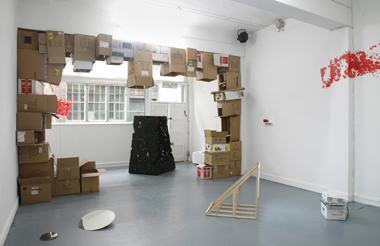 |
Better is something you build, 2008, installation view; courtesy Kevin Kavanagh Gallery |
Better is something you build consists of the work of five Irish and international artists; these are Graham Hudson, Gereon Krebber, Ulrich Vogl, Eamon O’Kane and Karin Brunnermeier. The show was curated by Jacqui McIntosh. It takes on the form of a variety of approaches, with most being site-specific installations and sculptures. Each artist’s work is easily distinguishable and this is further aided by the delegation of zones within the gallery space.
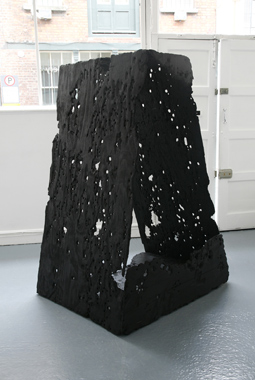 |
Gereon Krebber: Slice of a barricade, burnt timber and black emulsion, 2008; courtesy Kevin Kavanagh Gallery |
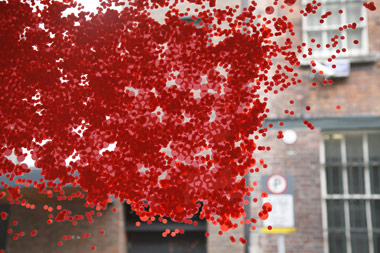 |
Gereon Krebber: Two stripes, masking dots, 2008; courtesy Kevin Kavanagh Gallery |
On entering the gallery it is German artist Gereon Krebber’s sculptural piece Slice of a barricade that first greets you. A timber sculpture that was set alight the night before the opening now bears the charcoaled scars of such an act. Black emulsion has also been used. It is large in scale, stopping at about chest height, and invites you to walk around it, to look at, through, down and above it. The act of burning the piece is in itself exciting but it does not translate through that effectively for the viewer and the importance of the act, which took place in a neighbouring car park, could be easily overlooked. Krebber’s other works in Better is something you build are also dominant features of the exhibition. Two stripes are narrow rectangular shapes formed from the layering of masking dots. They appear on separate walls and lie diagonally opposite each other. One of the rectangles covers both the wall and the window. Different-sized masking dots are used, all mainly red with the exception of some yellow and orange dots that are clustered together. They appear loosely within the confines of the rectangle and splatter over the edge, acting as paint would if thrown within a rectangular stencil.
 |
Eamon O’Kane: Untitled (season’s blockbuster), projected animation on wooden structure, 2007; courtesy Kevin Kavanagh Gallery |
Eamon O’Kane’s Untitled (season’s blockbuster) is a projection onto a wooden structure. The animation depicts one scene, a one-storey building dominated by the rising trees surrounding it. The animation takes the form of this scene being drawn; the outline of the image draws on the screen and then the outline is filled with colour; the animation then reverses all this and goes back to its original state; this then continues in a loop lasting no longer than a minute. The completed piece is not hung in the exhibition; instead the projector and screen are an integral a part of the exhibition. Indeed, there is a banality to the image that makes you wonder if the image being projected would be of any interest in and of itself. The process of the piece is the piece and the show’s title, Better is something we build, certainly applies: this piece is very much grounded in the exploration of the process of ‘build’, the transformation of a 2D image into a 3D sculptural piece.
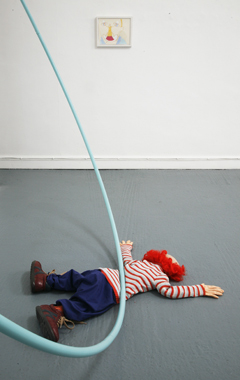 |
Karin Brunnermeier: Hansi-Nummer (ring clown), steel, enamel, clothes, 2007; courtesy Kevin Kavanagh Gallery |
A large steel ring rests against the back wall of the gallery; it lies upon clothing that combined together forms the remains of a clown crushed by the immense weight of the ring. This is one of two pieces in the exhibition by Karin Brunnermeier and is simply entitled Hansi-Nummer (ring clown). Her other piece is a painting of a clown’s face, the features of which are construced from figurative images of smaller clowns. The image is imperfect, with mistakes obvious.
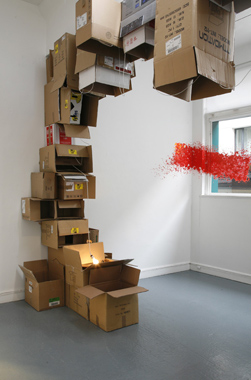 |
Graham Hudson: International, cardboard, turntables, light, LPs, 2008; courtesy Kevin Kavanagh Gallery |
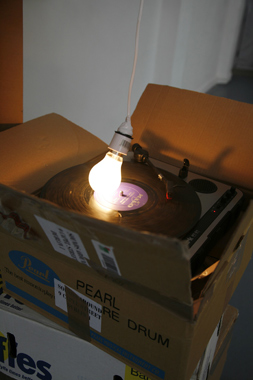 |
Graham Hudson: International (detail), cardboard, turntables, light, LPs, 2008; courtesy Kevin Kavanagh Gallery |
Graham Hudson’s International dominates the room; acting as an archway. The arch is construced out of brown cardboard boxes and Fyffes banana boxes. Two turntables are present, one on each side of the arch. Two lightbulbs are also present; lit, they each rest on a turntable. The speakers are hidden. The record players are old, as too are the records they play, one being The ace of clubs and the other Classics for pleasure . The sound fills the room. The lightbulbs rest on the spinning records as they rotate. When the arm of the record player reaches the half-way mark, the lightbulb knocks it off course; in the case of The ace of clubs this resulted in the same short piece of music being played over and over and over again in an almost demented fashion. In the case of Classics for pleasure the light-bulb moves in and out of the rotation of the record and therefore allows the record to play all the way through. The record finishes but the turntable continues to spin, the whir of the record replaces the music. The organic nature of the piece is fascinating and the aural experience will differ for every vistor. Hudson’s piece not only dominates because of its scale but also because of the quailty of its conception and execution.
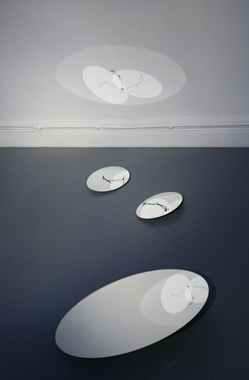 |
Ulrich Vogl: Limelight, mirror, ink, foil, 2008; courtesy Kevin Kavanagh Gallery |
The motif used in Ulrich Vogl’s two pieces, LimeLight and Stars, is a microphone complete with stand. LimeLight is constructed of three mirrors (one large and two small); printed on the two smaller mirrors is the silhouette of the microphone and stand. On the wall is a more detailed image of the microphone and stand. Light is projected onto the mirrors and results in a further image construction on the wall as the blacked out areas on the smaller mirrors form shadow casts from either side of the detailed mircophone and stand on the wall. The light hitting the wall acts as though a spotlight directed at the stage. Stars is a slide construced of tinfoil that is pierced with (what one assumes must be) the head of a pin to create an image. This is then placed within a slide viewer and then on a shelf in the exhibition. The microphone motif is again present, against the backdrop of a night sky laden with stars.
Better is something you build set forth to explore the development of sculpture from “a medium bound by the pedestal” [ 1 ] to its place in the digital age (think Duchamp’s readymades almost 100 years on). Better is something you build is also a re-emphasis on the ‘built’ 3D objects in a world of digital art.
Laura McGovern is a photographer practising in Dublin.